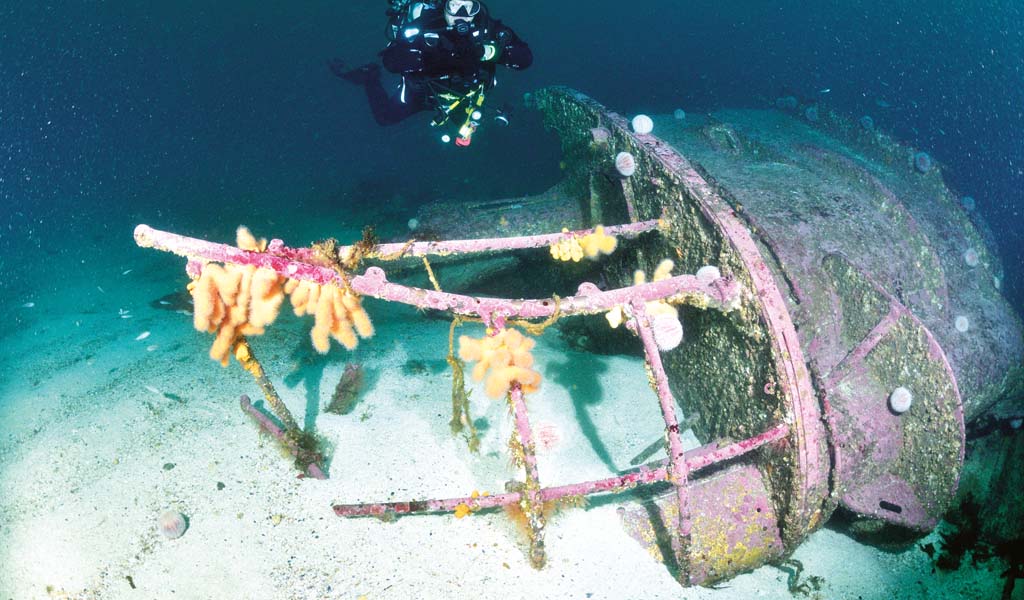
Anita Sherwood and her friends from Worcester BSAC embark on an epic RIB expedition to Shetland in which their training and resolve are tested to the max.
Oh my gosh! The weather was not looking good. In fact I had never seen such strong winds forecast, with gusts of Force 11 predicted midweek, dropping to Force 8 later. Having dedicated many hours of planning, with adventurous thoughts in mind, I’m guessing the Fair Isles were going to be out (48km offshore). Any diving was going to be a struggle! Without giving the story away, the week proved to be a survival experience that Bear Grylls would have been proud of. It was so bad that the wind speeds hit national headlines with storm Helen closely followed by storm Ali.
RIB in tow, the initial journey all went to plan. We collected our friend and fellow member Katie from Aberdeen – she had actually caught a flight from Sydney just to join us on this expedition. We caught the overnight ferry from Aberdeen to the Shetlands, giving us critical time to spend mulling over the sea charts and examining possible locations to dive in strong southerlies.
Plan formulated, we proposed to head for the north-facing Vidlin slip, where we would launch and motor up the coast with wild camping in the evening. Unfortunately, disaster struck as we were launching the RIB. The trailer winch handle was worn on the spindle and the only way to fix this was by welding it. Of all the days for this to happen it had to be a Sunday, when everything was closed.
Shetland BSAC to the rescue
We started phoning around in the hope someone in Shetland could help us. Our luck started to change as Chris contacted Andrew and Kelly Thomson from the local BSAC club. Believe it or not, Andrew worked for the Port Authority and had some people working on a Sunday who could sort us out. Within 30 minutes we were off to the port. Two huge double doors opened and we were escorted into the shelter of an incredibly large hangar, where statutory safety gear was promptly handed out.
In true ‘A-Team’ fashion, within minutes they had welded the handle. There was a sigh of relief, as none of us had expected for the problem to be solved that quickly. Andrew and Kelly waited patiently as we re-packed for the trip ahead. Packing complete, they were keen to hear our mad plans as I don’t think they get many divers quite like us. We were ushered into the boardroom and supplied with a very welcome hot chocolate and coffee. A chart of the islands was projected on a screen and dive plans were discussed along with checking of GPS references. We were overwhelmed by the fantastic hospitality.
Finally we were off, but the difficulties were still not over. Heading up the coast proved just too much. Our aim was to cross Yell Sound where we could seek shelter from the wind; but the rain and
sea spray was horizontal and even wearing our dive masks we were not able to see far enough ahead to navigate! We made the decision to turn back, as I had researched three reserve dive sites along that stretch of coastline.
The first two proved just too difficult, as collecting divers would have been too dangerous with strong winds catching the RIB. We finally opted for the third dive site, Grut Wick, which was tucked inside a cove and protected from the howling wind. We promptly moored up the boat with the idea of treating this site as a shore dive.
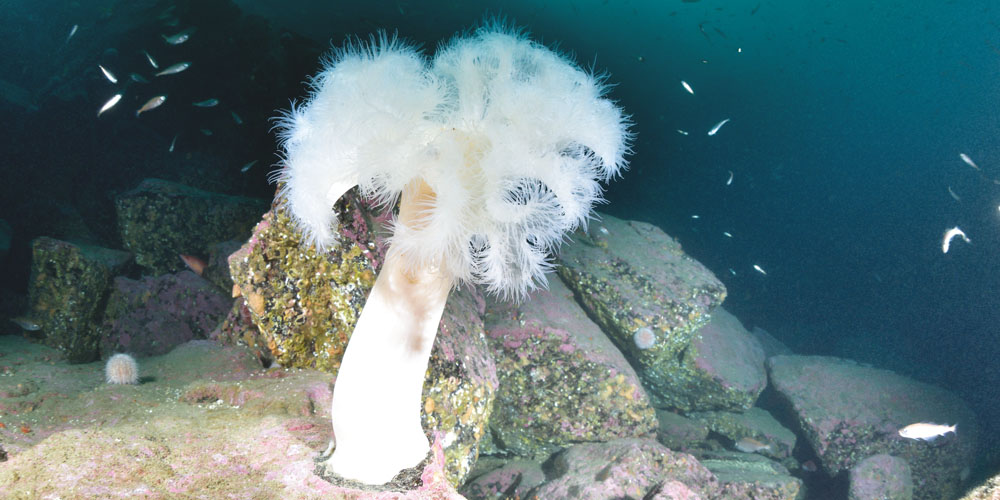
Shakedown dives
Grut Wick proved a great warm-up first dive. The topography was everything we had expected with an impressive cliff wall dropping down to at least 40 metres. We explored both sides of the bay entrance with the south side having the cliff wall and the north side a more gentle sloping wall, with areas absolutely plastered in feather stars.
As the RIB was already successfully moored up, we all decided this would be a great place to crash for the night. Before we knew it, our wild camp had been set up and Katie was cooking a superb tinned stew dinner. By morning the wind had slightly died down so we decided to make a second attempt to cross Yell Sound.
Success! Finally within the shelter of land we could now head for the steamship, the Jane. On 19 July 1923, the ship foundered after she ran aground on Linga island. The steamship was refloated as the tide rose but the damage was just too great and she sank shortly afterwards, thankfully with no loss of life.
Today the Jane lies at 20 metres on a bed of maerl, in an area of strong tidal streams attracting much marine life. At 60 metres long, the Jane is a perfect sized wreck to explore. Things are never that easy though. As I headed down the shot incredibly excited to have made it this far, my drysuit started to fill up with water and my flash head decided to pack up.
Determined I was not going to let this get the better of me, we arrived at midships with our torches on full beam, ready to explore. With a bit of careful spacial awareness of the girders, you could poke your head inside the engine room and view the inner workings of the engine, still in pretty good nick with the piston rods still attached to the crank. An oversized lobster tucked right inside, peered up. I presume it had an exit strategy, as it looked fairly wedged.
Continuing on to the stern you could head below the open overhanging structure with the prop shaft running along just at the back. The stern was the most impressive area with the four-bladed propeller still attached. The classic diver shot with Chris of course had to be taken. We had a quick look at the ship’s hull but decided the opposite side held the most interest.
We headed on to the bow, where the anchor and anchor winch had settled just away from the wreck, the anchor still securely in the hawse pipe. Time was up and we finally arrived on the surface to allow the next divers to enjoy the experience. The overwhelming consensus from everyone was that this had been a cracking dive.
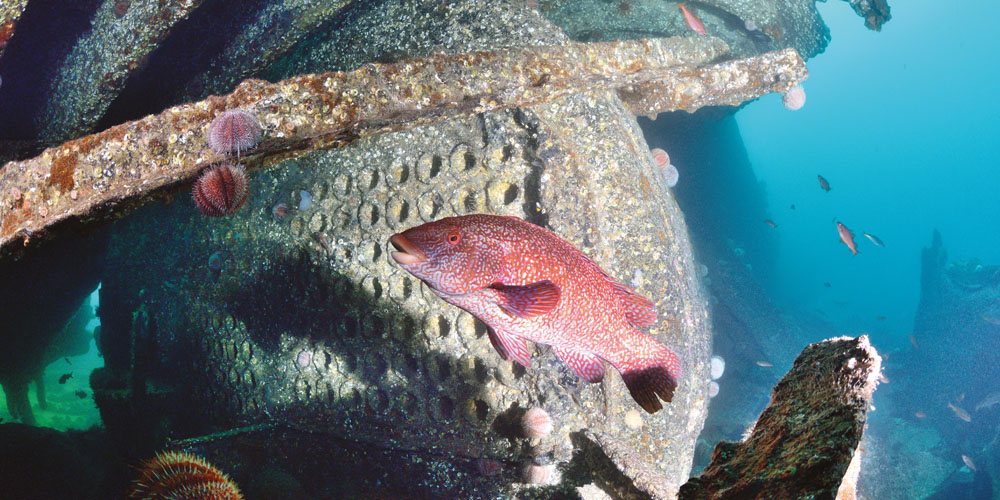
War grave on white sand
The afternoon’s dive was on E-49, a 60-metre-long submarine, resting at 32m on a white sandy seabed. The submarine sank in the First World War after hitting a mine laid by the German submarine UC76; a poignant dive as the crew were all lost.
To locate the sub on the echo sounder was incredibly hard, with just a tiny shadow on one of the three GPS references. We shot the wreck, half expecting to be diving on sand. Thankfully as we descended down the shot, the welcoming sight of the sub appeared. E-49 had sunk into the sand with only about a metre showing above the surface of the seabed. Apparently it’s the luck of the draw as to how much is uncovered after the occasional storm. Even though so little was exposed it was still a fascinating dive.
The wreck had been shot next to the bridge, which must have been the shadow on the echo sounder. The bridge still revealed its classic shapely form, with the periscope still attached. The journey to the stern took us over the sand-filled pressure hull, with occasional gaps where you could spot the classic red feelers of lobsters waving around.
The end of the sub appeared to peter out over the sand with just the recognisable stern mooring bollard left visible. We returned to the bridge, then headed towards the bow, where the wreck came to an abrupt end. The tip of the bow must have broken away on impact. After the storms of the previous night, the viz was not good enough to see far, but there were tell-tale signs of random metal leading across the seabed.
We knew we were getting close, as we could see shoals of fish hovering before we could see any wreckage. There isn’t a lot to look at, but it’s certainly worth the detour for completeness as you can view the forward anchor winch.
As we surfaced, the usual wind and rain had picked up. Surprisingly, Katie had a mobile signal and had noted that the weather forecast was improving for the following day. We only had enough food for two days but with this small window of opportunity
we decided to ration the meals and continue heading north. Our attention was soon drawn to our camp for the evening, so we had a quick scan of the charts and noticed there was safe anchorage in Balta Sound.
We pulled up on the slip in worsening conditions of heavy wind and rain, with the added discomfort of my water-logged drysuit. The thought of camping in these conditions weighed heavily on us all. Chris headed up the road to a nearby bungalow to find out who owned the adjacent field to seek permission for camping there. The Shetlanders’ generosity once again shone through, as they offered us the use of the Unst boat club boathouse. A bunch of bedraggled divers quickly turned into happy faces. It even had toilets!
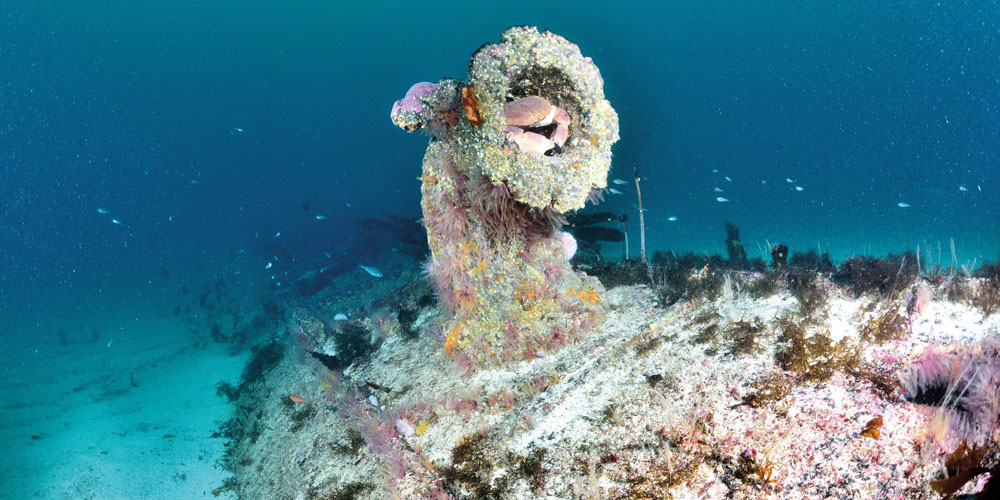
Snorkelling and sea caves
In the morning we left a donation in the way of a ‘thank you’ and continued on our journey. The sea was a little calmer but the swell was still there. We finally made it to the northern tip of the Shetland Islands. Wow, what a location! No boats, no houses, no anything; we were entirely on our own. A mysterious mist encircled the towering cliffs, gannets shrieked overhead and every corner the boat turned, revealed enticing tunnels and sea caves.
We only had a limited amount of full cylinders before our next gas run, so we decided to do two morning snorkels instead. The first was into Ruska Kane sea cave, where you don’t realise the immense scale until you head inside and gaze upwards. With our torches on and the constant water dripping from the ceiling, we floated into the darkness until we reached as far as possible. Our lights shone into the impenetrable dark void.
The second snorkel was through the Hols Hellier arch, which was deep enough for Chris to follow through with the RIB. The ceiling towered above us and the viz was so good, you could easily see the bottom at 10 metres. The subterranean walls were plastered with tiny plumose and jewel anemones. A couple of birds shot through the arch overhead and several seals darted by below.
Afterwards we headed to one of the UK’s most northerly lumps of rock, Muckle Flugga, to view the gannet colony. Pretty impressive I have to say! We had been monitoring the fuel closely and after much discussion we all agreed that although we had enough, our reserves were running low so headed back to Balta Sound on Unst – the only fuel pump on the entire island.
The tide was low on approach, so we couldn’t moor inshore, which unfortunately meant the fuel tanks would need to be carried across the rocky seaweed covered bay. A lot of huffing and puffing ensued, followed by the occasional slip. After several journeys back and forth the boat was re-fuelled. Next to the pump there was even a shop, which I was highly delighted at, as I had forgotten to pack my toothbrush. We could also stock up with food supplies, so no more rations. Hurrah!
We decided to head back to the west coast and cut up Bluemull Sound to dive Ousta Ness. The swell had picked up a bit here and although a good dive was had by all, the deco stop was a little uncomfortable. Down at 30 metres, the dive was calm and tranquil with sheer dramatic gullies and walls that nearly reached the surface. Where the gullies narrowed, the walls were covered in stunning displays of dead men’s fingers and jewel anemones.
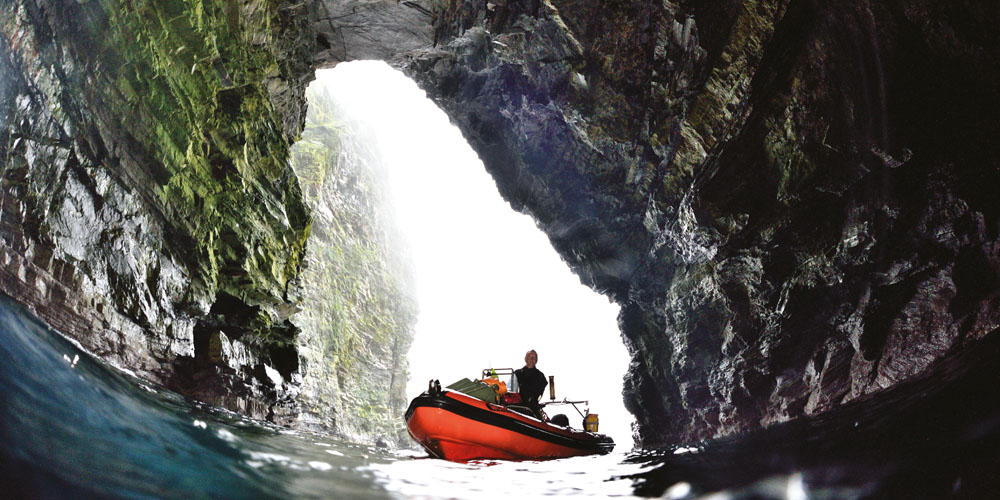
A storm coming…
The forecast had changed once more, with gusts up to Force 11 westerlies predicted for the following day, so it was time to make a hasty retreat and return back to Vidlin slip. After a quick call to the Coastguard to let them know we had arrived safely back, we recovered the boat and headed to Lerwick to meet Kelly and Andrew at Shetland BSAC to fill cylinders.
There was more Shetland generosity, as they kindly allowed us to bunk down in their boat shed for the night. That evening, everyone helped me test my drysuit (well, wetsuit) where low and behold I found a coin sized hole at the top of the wrist seal. The rest of the week was spent diving with a makeshift patch, but at least I knew where the problem was.
Exhausted from three hard days at sea, we were all too tired to dive plan for the storm that was due to hit us the following day. Morning arrived and a little more refreshed we decided to head for Muckle Roe island, with the intention of camping on the remote island of Vementry. We launched from Aith slip, which was north facing, with the idea of hugging the coastline in the lee of the wind.
The sea conditions were a little choppy but not too bad. With just a small swell we decided it was safe to dive under Muckle Roe lighthouse. It was an absolute pleasure to leave the driving rain on the surface and head down to a tranquil scene of gullies and shoals of fish. The dive plan involved surfacing near the cave entrance just below the lighthouse. As we approached the cave towards the end of the dive, there was more swell than expected but I guess being a cave it would be localised. The walls were festooned with colour and life.
I launched my DSMB from 6 metres, but unfortunately the swell caught me off-guard and the line tangled, forcing me to let go. No problem, as Mike had another one. After a successful launch, we surfaced in a ‘perfect storm’. The weather had certainly picked up. Our hearts were racing as we finned furiously away from the rocks. To add to the moment, there was no RIB in sight! Our dive training kicked in and we kept together, making ourselves as visible as possible, waving the SMB around.
It felt like an eternity but eventually the RIB appeared over the crest of the waves; it transpired they had been worried as well. After the excitement of the day, we decided one dive was quite enough and headed to Vementry to set up camp. As we approached the shore, we were greeted by three otters running down the bank towards us. There was a brief moment of joy, but it all changed in a second as almost horizontal hail started to hit us hard, as we all crouched in a huddle on the boat.
The location was just going to be too exposed to camp, so we headed around the island, checking out each bay until we found the perfect spot to moor. Although with gusts of up to Force 11, nowhere was entirely out of the wind. The campsite wasn’t perfect, but it would do. We put the tents up one at time as a group effort, with all of us weighting down the flapping material. While trying to shelter from the driving rain, Katie managed to whip us up a tinned stew dinner. This went down well as we made a quick retreat to the tents to get out of the wind.
The wind picked up and the rain got heavier. By midnight the whole structure of the tent was constantly bending as we desperately tried to hold up the tent poles, taking it in shifts to sleep. Somehow, I actually fell asleep while holding up the tent. I occasionally peered outside to check the RIB. We texted the lads to see if their tents were okay, but no message came back. Chris was fast asleep in his old canvas tent, that had many a tale to tell. Mike’s tent didn’t fare so well and he spent most of the night with the wet tent collapsed on top of him. He came out in the middle of the night to check if we were okay and adjust his guylines. What a star!
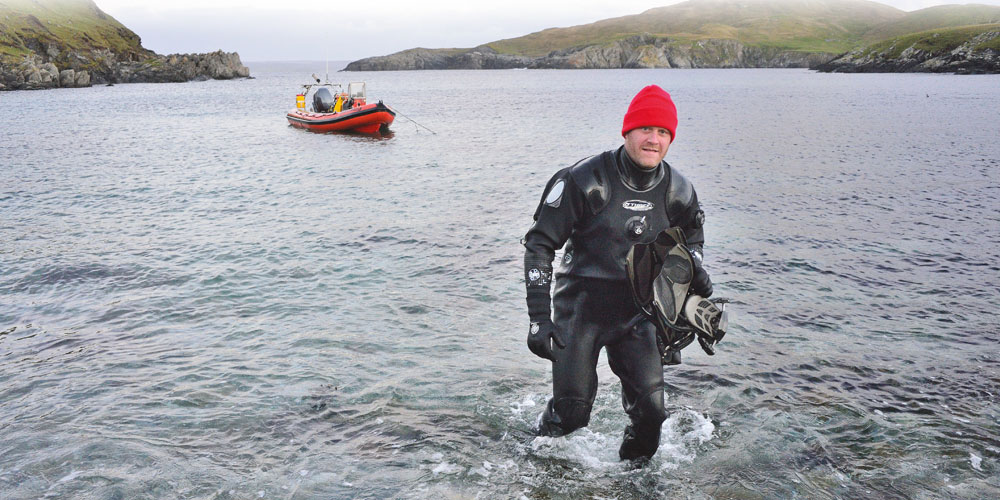
Dive sites
Grut Wick: 60°24.911’N 1º05.096’W - SS Jane: 60º38.467’N 0º56.613’W
E-49: 60º44.208’N 0º47.929’W - Muckle Roe Lighthouse: 60º20.883’N 1º 27.061’W
Ruska Kane: 60º50.395’N 0º50.265’W - Hols Helier Arch: 60º50.230’N 0º50.908’W
Expedition team
Anita Sherwood: Advanced Diver Chris Redman: Dive Leader
Mike Bonner: Dive Leader Katie Rushforth: Sports Diver
With thanks to Shetland BSAC, tel 07828 512753
This UK Diving article was originally published in SCUBA magazine, Issue 98 January 2020.
Featured image by Anita Sherwood - Mike checks out the conning tower of submarine E49.
Anita is also the author of two beautifully illustrated, authoritative guides to UK shore diving, find out more.

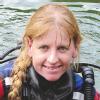 Author: Anita Sherwood | Posted 07 Nov 2020
Author: Anita Sherwood | Posted 07 Nov 2020



